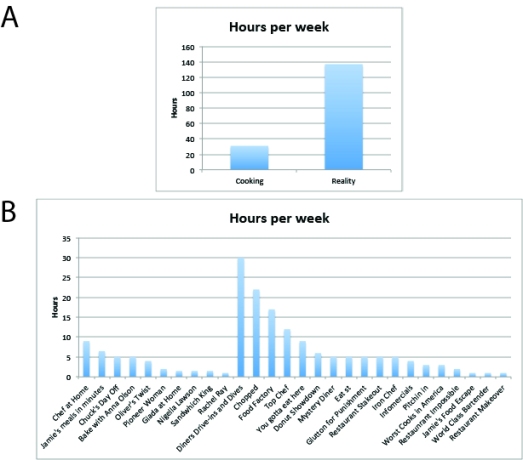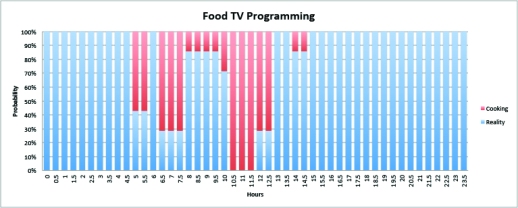Abstract: Television has a history of airing programs that describe and instruct on how to cook at home. The Food Network is a provider of such content, however the actual programming featuring food preparation for the home chef has been declining in recent years. In this work, the authors have taken a sample of programs and used it to deconstruct what shows are aired, and what the aired shows tells us about how network programmers perceive their audience.
Introduction:
The Food Network (FoodTV) constitutes a cable channel which broadcasts television (TV) shows catering to food. As with any network, it broadcasts a range of programming. At FoodTV’s conception in 1993, they featured cooking shows heavily where a chef cooked meals and gave a description of how to recreate the dish in a home setting. This tradition continued over the course of the 1990’s but began to change in the late 1990’s and early 2000’s to reflect the changes in television.
The change that swept the networks was of course reality TV. The global popularity of iconic programs such as Survivor and Big Brother spawned generations of reality TV that continue in current programming. FoodTV incorporated reality TV to adapt itself to modern programming and began broadcasting increased reality content. One notable example is this of Iron Chef
Like FoodTV, Iron Chef (a Japanese reality cooking competition) was first broadcast in 1993. Iron Chef found it’s way onto North American boradcasting with an English dub and gained traction as a cult favourite for it’s camp style and exotic fare (umeboshi, shark fin, eel farts, and other ingredients not common to North Americans). Although Iron Chef ended it’s run in 1999, countries around the world including the USA produced their own version of Iron Chef. Many shows now replicate this style of competition cooking featuring set time limits and ingredients. This is not to say it is the only reality TV featured on FoodTV. The network has aimed to appeal to a mass audience with a mix of reality TV ranging from competition to restaurant reviews and cultural exploration via food.
The range of shows now broadcast on FoodTV is not necessarily a reflection of the audience, but is most certainly a reflection of how executives and network programmers see their audience. To this end, we aim to display a snapshot of current FoodTV programming. The authors hypothesize that FoodTV now airs a disproportionate amount of reality TV in relation to cooking shows. The authors also feel that this is detrimental in general to viewership owing to the repetitiveness of shows aired.
Methods:
To ascertain the content of programming on FoodTV, the authors began by classifying programs into either “Cooking” or “Reality” as defined as follows:
“Cooking” shows aim to impart knowledge directly to the audience on how to cook food products and create meals. They will contain recipes with specific quantifiable values of all ingredients (cups, tablespoons, number and size of product e.g. 2 large potatoes, pinch, pound, etc) and a protocol which may vary in detail dictating how to combine the ingredients to create the desired finished product (“Add 1tsp salt and 1tbsp sugar to the dry ingredients and sift together.”). The amount of recipes may range from one to ten depending on the show and the amount of detail imparted per recipe. Secondary goals of a Cooking show are to teach skills and background knowledge which may be helpful in future meal preparations. This includes but is not limited to products to use/buy, flavour pairings, decoration, and technical skills.
“Reality” shows aim to impart entertainment as a primary goal. They will not contain complete recipes. This may mean ingredients are purposely left out (“This is my secret ingredient! I can’t share what it is!”), methods are deliberately obscured (“I can’t tell you how we get the mac and cheese into the chicken wing, it’s a secret.”) or completely glossed over (“I created a braising liquid, then finished my prep work and made this dish.”), or that the recipe may be meant only for demonstrative purposes and is not meant for the home cook (“Then we put the fructose mix into our 5kg mixing barrel and pump through maltodextrin before putting it through the high pressure extruder/fryer.”). Multiple recipes may be shown in a reality show, but none will provide enough information to recreate the food shown. Secondary goals of a Reality show are to spotlight different food-related establishments and notable chefs, entertain via competitions, or investigate a particular food culture, or practice.
The authors used publicly available information regarding aired programming from the Canadian FoodTV network (http://www.foodnetwork.ca/) for the period of April 21st 2013 00:00 EST to April 27th 2013 23:30 EST. Listed shows were categorized as Cooking or Reality based on matching criteria to the above indicators. Shows were then compared based on type (Reality vs Cooking), and air time to establish results.
Results:
FoodTV airs a large majority of Reality shows
When broken down as either Reality or Cooking, the FoodTV programming is 18.45% Cooking shows and 81.55% Reality shows. Based on hours of the week, this corresponds to 31 hours/week(hr/w) of Cooking and 137hr/w of Reality aired. Each type of show was further broken down into it’s various aired shows during the analysis period. The average hours aired for any specific cooking show is 3.70hr/w versus Reality show gets an average of 7.56hr/w. Reality is clearly the predominant type of show aired, and each show broadcast is likely to receive twice the air time as it’s Cooking sister show. Reality also enjoys a greater number of overall shows broadcast than Cooking (18 vs 10, or again almost double the amount).
Within shows broadcast, Cooking shows have relatively constant content; a chef who relates recipes to the audience for roughly 30min. The content of Reality shows varies much more. They contain restaurant review shows, elimination-style competitions, makeover shows, and hidden camera shows to name the more popular emissions.
 Figure 1: FoodTV broadcast shows. Hours of shows aired per week on FoodTV are broken down by type of show (A), and then further broken down into specific shows aired (B).
Figure 1: FoodTV broadcast shows. Hours of shows aired per week on FoodTV are broken down by type of show (A), and then further broken down into specific shows aired (B).
Cooking shows air during daytime hours while Reality shows air during primetime.
For each 30min time slot of the day, beginning at 00:00 and ending at 23:30, the probability was calculated of whether the program would be Cooking or Reality. In general, there is probability of finding a Reality show at all times of the day with the exception of 10:30-12:00. Probability of catching a Cooking show begins at 5:00, peaks from 10:30-12:00 with 100%, and finishes at 15:00 at which the probability of catching a Cooking show drops back to 0%.
Figure 2: Daily schedule visualized. All programming for seven days is averaged to show a typical daily broadcast, starting at 00:00 (0.0) and extending to 23:30 (23.5).
Discussion:
To begin discussing the importance of programming, we must understand the benefits bestowed by both Reality and Cooking shows. Cooking shows give clear instructional insights into food preparation and aid viewers in creating flavour combinations they may not have thought of. Viewers, including the authors, have expressed the opinion that Cooking shows have been a key stepping stone to learning in a kitchen environment. The drawback of Cooking shows is that care must be taken in which recipes may be followed at home. For example, although Jaime Oliver recipes frequently appear simple and appealing, the flavour when made in the author’s kitchen is less than desirable giving the effect of “Oh wow, I thought this would be amazing but it’s just kind of funny tasting.” By contrast, Gordon Ramsay recipes are much more frequently deemed “OMG so gooood, we’re totally making this again!!” Overall, Cooking shows bestow important culinary education not otherwise available to a self-taught chef.
Reality shows may infrequently aid in cooking inspiration, but will almost never afford the viewer a recipe which can be followed. Some genres of Reality shows such as Diners Drive-ins and Dives or You Gotta Eat Here provide information which constitutes a visual restaurant review. These reviews are mostly useful if the viewers wish to find a restaurant with enough fat content in the menu to aid in the development of early cardiovascular disease, however the authors do fully concede that the colloquialism “fat is flavour” was not made in error. Competitive Reality shows (Top Chef, Chopped, Iron Chef) provide entertainment but tips that are only helpful to a more experienced cook. The amateur home cook is unlikely to seek advice for cooking ingredients such as foie gras, ramps, or olive oil gelato.
Now that we have established the broadcasted content deemed appropriate by FoodTV programmers, we must reflect on what this programming tells us about viewership. The primary finding is that programmers believe an audience interested in useful cooking information exists only in the morning and early afternoon. This group is often generalized as containing “stay at home” parents. During primetime and late evening periods, the programming is exclusively Reality shows. These are prime viewing hours for what is generalized as the “hardworking full-timers.” The message that can be taken from programmers is that only those with small children are and should be interested in how to cook. Those with “real” jobs that are away during daytime hours could only be interested in entertainment, and have no real interest in actual cooking.
At the current rate of elimination of Cooking shows from FoodTV’s line up, it is possible to assume the trend will continue leading to a possible total elimination of Cooking shows. This is not an impossibility as a similar, yet total shift has already occurred on another station: TLC used to be an abbreviation of The Learning Channel, but now represents only a title as viewers would be hard-pressed to call any TLC programming “learning”. With the elimination of Cooking, and domination of Reality shows, it is possible that we may see a decrease in home cooking, and the knowledge of how to cook, with shows increasingly pulling away from any food information and focusing instead on interpersonal drama and competition.
